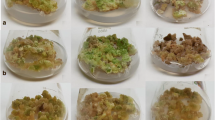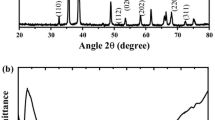Abstract
Accumulation of secondary metabolites in medicinal plants by giving abiotic/biotic stress is, nowadays, an active area of research. This study reports the inoculation of ZnO and CuO nanoparticles in Murashige and Skoog (MS) medium having plant growth regulators for the regeneration of callus from leaf explants of medicinal plant, Stevia rebaudiana. Presence of ZnO and CuO nanoparticles in different concentrations results in conferring different kinds of physiology in different regenerants. 1 and 10 mg/L have been declared the best ZnO and CuO nanoparticles concentrations regarding various physiological parameters. Steviol glycosides have not been detected in any callus treatment. Moreover, the phytochemical characteristics of S. rebaudiana under different ZnO and CuO nanoparticles concentrations have been exploited. The highest amount of total phenolic content (TPC), total flavonoid content (TFC), total antioxidant capacity (TAC) and 1,1-diphenyl-2-picrylhydrazyl (DPPH) free radical scavenging activity has been obtained at 100 mg/L of ZnO nanoparticles, whereas TPC, TAC, TRP and DPPH free radical scavenging activity have been achieved highest at 10 mg/L concentration of CuO nanoparticles. However, the highest TRP in the context of ZnO and the highest TFC regarding CuO have been achieved at 50 and 100 mg/L, respectively. This clearly indicates that CuO nanoparticles are more toxic to Stevia callus as compared to ZnO nanoparticles, and opens avenues for future studies utilizing ZnO or CuO nanoparticles for the enhancement of commercially important secondary metabolites in different medicinal plants.


Similar content being viewed by others
References
Chang, Y.N., M. Zhang, L. **a, J. Zhang, and G. **ng. 2012. The toxic effects and mechanisms of CuO and ZnO nanoparticles. Materials 5(12): 2850–2871.
Chen, J.C., and C.T. Tang. 2007. Preparation and application of granular ZnO/Al2O3 catalyst for the removal of hazardous trichloroethylene. Journal of Hazardous Materials 142(1–2): 88–96.
Choi, O., and Z. Hu. 2008. Size dependent and reactive oxygen species related nanosilver toxicity to nitrifying bacteria. Environmental Science and Toxicology 42(12): 4583–4588.
Gupta, P., S. Sharma, and S. Saxena. 2015. Biomass yield and steviol glycoside production in callus and suspension culture of Stevia rebaudiana treated with proline and polyethylene glycol. Applied Biochemistry and Biotechnology 176(3): 863–874.
Haq, I.U., N. Ullah, G. Bibi, S. Kanwal, M.S. Ahmad, and B. Mirza. 2012. Antioxidant and cytotoxic activities and phytochemical analysis of Euphorbia wallichii root extract and its fractions. Iranian Journal of Pharmaceutical Research 11(1): 241–249.
Hendawey, M.H., and R.E. Abo El Fadl. 2014. Biochemical studies on the production of active constituents in Stevia rebaudiana L. callus. Global Journal of Biotechnology and Biochemistry 9(3): 76–93.
Hendawey, M.H., R.E.A. El-Fadl, and T.A.S. El-Din. 2015. Biochemical role of some nanoparticles in the production of active constituents in Stevia rebaudiana L. callus. Life Science Journal 12(7): 144–156.
Jafri, L., S. Saleem, I.U. Haq, N. Ullah, and B. Mirza. 2014. In vitro assessment of antioxidant potential and determination of polyphenolic compounds of Hedera nepalensis K. Koch. Arabian Journal of Chemistry 10(2): S3699–S3706.
Javed, R., M. Ahmed, I.U. Haq, S. Nisa, and M. Zia. 2017a. PVP and PEG doped CuO nanoparticles are more biologically active: Antibacterial, antioxidant, antidiabetic and cytotoxic perspective. Material Science and Engineering C 79: 108–115.
Javed, R., M. Usman, S. Tabassum, and M. Zia. 2016. Effect of cap** agents: Structural, optical and biological properties of ZnO nanoparticles. Applied Surface Science 386: 319–326.
Javed, R., M. Usman, B. Yucesan, M. Zia, and E. Gurel. 2017b. Effect of zinc oxide (ZnO) nanoparticles on physiology and steviol glycosides production in micropropagated shoots of Stevia rebaudiana Bertoni. Plant Physiology and Biochemistry 110: 94–99.
Javed, R., B. Yucesan, and E. Gurel. 2017c. Hydrogen peroxide-induced steviol glycosides accumulation and enhancement of antioxidant activities in leaf tissues of Stevia rebaudiana Bertoni. Sugar Tech. doi:10.1007/s12355-017-0521-y.
Khalil, S.A., N. Ahmad, and R. Zamir. 2015. Gamma radiation induced variation in growth characteristics and production of bioactive compounds during callogenesis in Stevia rebaudiana (Bert.). New Negatives in Plant Science 1–2: 1–5.
Lee, C.W., S. Mahendra, K. Zodrow, D. Li, Y.-C. Tsai, J. Braam, and P.J.J. Alvares. 2010. Developmental phytotoxicity of metal oxide nanoparticles to Arabidopsis thaliana. Environmental Toxicology and Chemistry 29(3): 669–675.
Lee, W.M., Y.J. An, H. Yoon, and H.S. Kweon. 2008. Toxicity and bioavailability of copper nanoparticles to the terrestrial plants Mung bean (Phaseolus radiatus) and Wheat (Triticum aestivum): Plant agar test for water-insoluble nanoparticles. Environmental Toxicology and Chemistry 27(9): 1915–1921.
Lin, D., and B. **ng. 2008. Root uptake and phytotoxicity of ZnO nanoparticles. Environmental Science and Technology 42(15): 5580–5585.
Murashige, T., and F. Skoog. 1962. A revised medium for rapid growth and bioassays with tobacco tissue cultures. Plant Physiology 15: 473–497.
Nagajyothi, P.C., T.V.M. Sreekanth, C.O. Tettey, Y.I. Jun, and S.H. Mook. 2014. Characterization, antibacterial, antioxidant, and cytotoxic activities of ZnO nanoparticles using Coptidis rhizoma. Bioorganic & Medicinal Chemistry Letters 24(17): 4298–4303.
Pandurangan, M., and D.H. Kim. 2013. ZnO nanoparticles augment ALT, AST, ALP and LDH expressions in C2C12 cells. Saudi Journal of Biological Sciences 22(6): 679–684.
Phiwdang, K., S. Suphankij, W. Mekprasart, and W. Pecharapa. 2013. Synthesis of CuO nanoparticles by precipitation method using different precursors. Energy Procedia 34: 740–745.
Rafiq, M., M.U. Dahot, S.M. Mangrio, H.A. Naqvi, and I.A. Qarshi. 2007. In vitro clonal propagation and biochemical analysis of field established Stevia rebaudiana Bertoni. Pakistan Journal of Botany 39(7): 2467–2474.
Shahmiri, M., N.A. Ibrahim, N. Zainuddin, N. Asim, B. Bakhtyar, A. Zaharim, and K. Sopian. 2013. Effect of pH on the synthesis of CuO nanosheets by quick precipitation method. WSEAS Transactions on Environment and Development 9(2): 137–145.
Sharma, D., J. Rajput, B.S. Kaith, K. Mohinder, and S. Sapna. 2010. Synthesis of ZnO nanoparticles and study of their antibacterial and antifungal properties. Thin Solid Films 519(3): 1224–1229.
Shaw, A.K., and Z. Hossain. 2013. Impact of nano-CuO stress on rice (Oryza sativa L.) seedlings. Chemosphere 93(6): 906–915.
Shivanna, N., M. Naika, F. Khanum, and V.K. Kaul. 2012. Antioxidant, anti-diabetic and renal protective properties of Stevia rebaudiana. Journal of Diabetes and Its Complications 27(2): 103–113.
Singh, A.K., V. Viswanath, and V.C. Janu. 2009. Synthesis, effect of cap** agents, structural, optical and photoluminescence properties of ZnO nanoparticles. Journal of Lumininescence 129(8): 874–878.
Thiyagarajan, M., and P. Venkatachalam. 2012. Large scale in vitro propagation of Stevia rebaudiana (bert) for commercial application: Pharmaceutically important and antidiabetic medicinal herb. Industrial Crops and Products 37(1): 111–117.
Yucesan, B., R. Büyükgöçmen, A. Mohammed, S. Muhammed, C. Altug, S. Gurel, and E. Gurel. 2016. An efficient regeneration system and steviol glycoside analysis of Stevia rebaudiana Bertoni, a source of natural high-intensity sweetener. Vitro Cellular and Developmental Biology-Plant 52(3): 330–337.
Acknowledgements
Rabia Javed is grateful to The Scientific and Technological Research Council of Turkey, TUBİTAK (Programme No: 2216), for providing financial support to conduct this research. Authors are also thankful to the Department of Biotechnology, QAU, Pakistan, and Department of Biology, AIBU, Turkey, for providing all the required facilities.
Author information
Authors and Affiliations
Contributions
RJ conceived the idea, did experimental work, and wrote the manuscript. BY, MZ and RJ analyzed the data. MZ and EG critically reviewed the manuscript and added to its technical part. All authors have contributed, seen and approved the manuscript.
Corresponding author
Ethics declarations
Conflict of interest
The authors declare that they have no conflict of interest.
Rights and permissions
About this article
Cite this article
Javed, R., Yucesan, B., Zia, M. et al. Elicitation of Secondary Metabolites in Callus Cultures of Stevia rebaudiana Bertoni Grown Under ZnO and CuO Nanoparticles Stress. Sugar Tech 20, 194–201 (2018). https://doi.org/10.1007/s12355-017-0539-1
Received:
Accepted:
Published:
Issue Date:
DOI: https://doi.org/10.1007/s12355-017-0539-1




